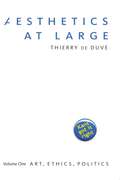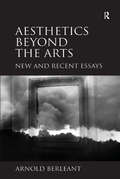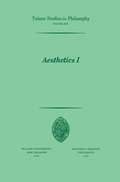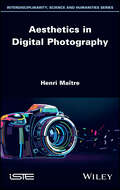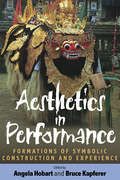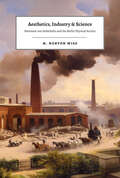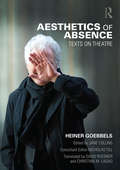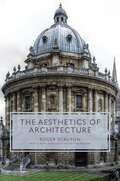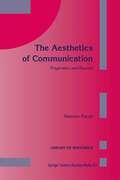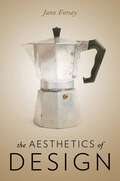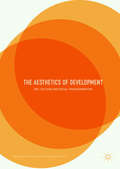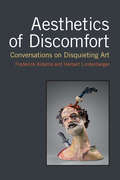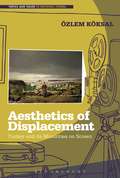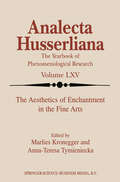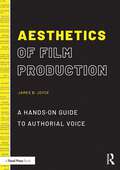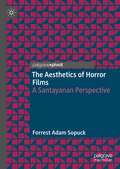- Table View
- List View
Aesthetics at Large: Volume 1: Art, Ethics, Politics
by Thierry de DuveImmanuel Kant’s Critique of Judgment, Thierry de Duve argues in the first volume of Aesthetics at Large, is as relevant to the appreciation of art today as it was to the enjoyment of beautiful nature in 1790. Going against the grain of all aesthetic theories situated in the Hegelian tradition, this provocative thesis, which already guided de Duve’s groundbreaking book Kant After Duchamp (1996), is here pursued in order to demonstrate that far from confining aesthetics to a stifling formalism isolated from all worldly concerns, Kant’s guidance urgently opens the understanding of art onto ethics and politics. Central to de Duve’s re-reading of the Critique of Judgment is Kant’s idea of sensus communis, ultimately interpreted as the mere yet necessary idea that human beings are capable of living in peace with one another. De Duve pushes Kant’s skepticism to its limits by submitting the idea of sensus communis to various tests leading to questions such as: Do artists speak on behalf of all of us? Is art the transcendental ground of democracy? Or, Was Adorno right when he claimed that no poetry could be written after Auschwitz? Loaded with de Duve’s trademark blend of wit and erudition and written without jargon, these essays radically renew current approaches to some of the most burning issues raised by modern and contemporary art. They are indispensable reading for anyone with a deep interest in art, art history, or philosophical aesthetics.
Aesthetics at Large: Volume 1: Art, Ethics, Politics
by Thierry de DuveImmanuel Kant’s Critique of Judgment, Thierry de Duve argues in the first volume of Aesthetics at Large, is as relevant to the appreciation of art today as it was to the enjoyment of beautiful nature in 1790. Going against the grain of all aesthetic theories situated in the Hegelian tradition, this provocative thesis, which already guided de Duve’s groundbreaking book Kant After Duchamp (1996), is here pursued in order to demonstrate that far from confining aesthetics to a stifling formalism isolated from all worldly concerns, Kant’s guidance urgently opens the understanding of art onto ethics and politics. Central to de Duve’s re-reading of the Critique of Judgment is Kant’s idea of sensus communis, ultimately interpreted as the mere yet necessary idea that human beings are capable of living in peace with one another. De Duve pushes Kant’s skepticism to its limits by submitting the idea of sensus communis to various tests leading to questions such as: Do artists speak on behalf of all of us? Is art the transcendental ground of democracy? Or, Was Adorno right when he claimed that no poetry could be written after Auschwitz? Loaded with de Duve’s trademark blend of wit and erudition and written without jargon, these essays radically renew current approaches to some of the most burning issues raised by modern and contemporary art. They are indispensable reading for anyone with a deep interest in art, art history, or philosophical aesthetics.
Aesthetics beyond the Arts: New and Recent Essays
by Arnold BerleantTaking the view that aesthetics is a study grounded in perception, the essays in this volume exhibit many sides of the perceptual complex that is the aesthetic field and develop them in different ways. They reinvigorate our understanding of such arts as music and architecture; they range across the natural landscape to the urban one; they reassess the place of beauty in the modern environment and reassess the significance of the contributions to aesthetic theory of Kant and Dewey; and they broach the kinds of meanings and larger understanding that aesthetic engagement with the human environment can offer. Written over the past decade, these original and innovative essays lead to a fresh encounter with the possibilities of aesthetic experience, one which has constantly evolved, moving in recent years in the direction of what Berleant terms 'social aesthetics', which enhances human-environmental integration and sociality.
Aesthetics beyond the Arts: New and Recent Essays
by Arnold BerleantTaking the view that aesthetics is a study grounded in perception, the essays in this volume exhibit many sides of the perceptual complex that is the aesthetic field and develop them in different ways. They reinvigorate our understanding of such arts as music and architecture; they range across the natural landscape to the urban one; they reassess the place of beauty in the modern environment and reassess the significance of the contributions to aesthetic theory of Kant and Dewey; and they broach the kinds of meanings and larger understanding that aesthetic engagement with the human environment can offer. Written over the past decade, these original and innovative essays lead to a fresh encounter with the possibilities of aesthetic experience, one which has constantly evolved, moving in recent years in the direction of what Berleant terms 'social aesthetics', which enhances human-environmental integration and sociality.
Aesthetics I (Tulane Studies in Philosophy #19)
by Ramona Cormier Shannon Dubose James K. Feibleman John D. Glenn Harold N. Lee Marian L. Pauson Louise N. Roberts John SallisAesthetics in Digital Photography
by Henri MaîtreAutomatically evaluating the aesthetic qualities of a photograph is a current challenge for artificial intelligence technologies, yet it is also an opportunity to open up new economic and social possibilities.Aesthetics in Digital Photography presents theories developed over the last 25 centuries by philosophers and art critics, who have sometimes been governed by the objectivity of perception, and other times, of course, by the subjectivity of human judgement. It explores the advances that have been made in neuro-aesthetics and their current limitations.In the field of photography, this book puts aesthetic hypotheses up against experimental verification, and then critically examines attempts to “scientifically” measure this beauty. Special attention is paid to artificial intelligence techniques, taking advantage of machine learning methods and large databases.
Aesthetics in Digital Photography
by Henri MaîtreAutomatically evaluating the aesthetic qualities of a photograph is a current challenge for artificial intelligence technologies, yet it is also an opportunity to open up new economic and social possibilities.Aesthetics in Digital Photography presents theories developed over the last 25 centuries by philosophers and art critics, who have sometimes been governed by the objectivity of perception, and other times, of course, by the subjectivity of human judgement. It explores the advances that have been made in neuro-aesthetics and their current limitations.In the field of photography, this book puts aesthetic hypotheses up against experimental verification, and then critically examines attempts to “scientifically” measure this beauty. Special attention is paid to artificial intelligence techniques, taking advantage of machine learning methods and large databases.
Aesthetics in Performance: Formations of Symbolic Construction and Experience
In various ways, the essays presented in this volume explore the structures and aesthetic possibilities of music, dance and dramatic representation in ritual and theatrical situations in a diversity of ethnographic contexts in Europe, the Americas, Africa and Asia. Each essay enters into a discussion of the “logic” of aesthetic processes exploring their social and political and symbolic import. The aim is above all to explore the way artistic and aesthetic practices in performance produce and structure experience.
Aesthetics, Industry, and Science: Hermann von Helmholtz and the Berlin Physical Society
by M. Norton WiseOn January 5, 1845, the Prussian cultural minister received a request by a group of six young men to form a new Physical Society in Berlin. In fields from thermodynamics, mechanics, and electromagnetism to animal electricity, ophthalmology, and psychophysics, members of this small but growing group—which soon included Emil Du Bois-Reymond, Ernst Brücke, Werner Siemens, and Hermann von Helmholtz—established leading positions in what only thirty years later had become a new landscape of natural science. How was this possible? How could a bunch of twenty-somethings succeed in seizing the future? In Aesthetics, Industry, and Science M. Norton Wise answers these questions not simply from a technical perspective of theories and practices but with a broader cultural view of what was happening in Berlin at the time. He emphasizes in particular how rapid industrial development, military modernization, and the neoclassical aesthetics of contemporary art informed the ways in which these young men thought. Wise argues that aesthetic sensibility and material aspiration in this period were intimately linked, and he uses these two themes for a final reappraisal of Helmholtz’s early work. Anyone interested in modern German cultural history, or the history of nineteenth-century German science, will be drawn to this landmark book.
Aesthetics, Industry, and Science: Hermann von Helmholtz and the Berlin Physical Society
by M. Norton WiseOn January 5, 1845, the Prussian cultural minister received a request by a group of six young men to form a new Physical Society in Berlin. In fields from thermodynamics, mechanics, and electromagnetism to animal electricity, ophthalmology, and psychophysics, members of this small but growing group—which soon included Emil Du Bois-Reymond, Ernst Brücke, Werner Siemens, and Hermann von Helmholtz—established leading positions in what only thirty years later had become a new landscape of natural science. How was this possible? How could a bunch of twenty-somethings succeed in seizing the future? In Aesthetics, Industry, and Science M. Norton Wise answers these questions not simply from a technical perspective of theories and practices but with a broader cultural view of what was happening in Berlin at the time. He emphasizes in particular how rapid industrial development, military modernization, and the neoclassical aesthetics of contemporary art informed the ways in which these young men thought. Wise argues that aesthetic sensibility and material aspiration in this period were intimately linked, and he uses these two themes for a final reappraisal of Helmholtz’s early work. Anyone interested in modern German cultural history, or the history of nineteenth-century German science, will be drawn to this landmark book.
Aesthetics, Industry, and Science: Hermann von Helmholtz and the Berlin Physical Society
by M. Norton WiseOn January 5, 1845, the Prussian cultural minister received a request by a group of six young men to form a new Physical Society in Berlin. In fields from thermodynamics, mechanics, and electromagnetism to animal electricity, ophthalmology, and psychophysics, members of this small but growing group—which soon included Emil Du Bois-Reymond, Ernst Brücke, Werner Siemens, and Hermann von Helmholtz—established leading positions in what only thirty years later had become a new landscape of natural science. How was this possible? How could a bunch of twenty-somethings succeed in seizing the future? In Aesthetics, Industry, and Science M. Norton Wise answers these questions not simply from a technical perspective of theories and practices but with a broader cultural view of what was happening in Berlin at the time. He emphasizes in particular how rapid industrial development, military modernization, and the neoclassical aesthetics of contemporary art informed the ways in which these young men thought. Wise argues that aesthetic sensibility and material aspiration in this period were intimately linked, and he uses these two themes for a final reappraisal of Helmholtz’s early work. Anyone interested in modern German cultural history, or the history of nineteenth-century German science, will be drawn to this landmark book.
Aesthetics, Industry, and Science: Hermann von Helmholtz and the Berlin Physical Society
by M. Norton WiseOn January 5, 1845, the Prussian cultural minister received a request by a group of six young men to form a new Physical Society in Berlin. In fields from thermodynamics, mechanics, and electromagnetism to animal electricity, ophthalmology, and psychophysics, members of this small but growing group—which soon included Emil Du Bois-Reymond, Ernst Brücke, Werner Siemens, and Hermann von Helmholtz—established leading positions in what only thirty years later had become a new landscape of natural science. How was this possible? How could a bunch of twenty-somethings succeed in seizing the future? In Aesthetics, Industry, and Science M. Norton Wise answers these questions not simply from a technical perspective of theories and practices but with a broader cultural view of what was happening in Berlin at the time. He emphasizes in particular how rapid industrial development, military modernization, and the neoclassical aesthetics of contemporary art informed the ways in which these young men thought. Wise argues that aesthetic sensibility and material aspiration in this period were intimately linked, and he uses these two themes for a final reappraisal of Helmholtz’s early work. Anyone interested in modern German cultural history, or the history of nineteenth-century German science, will be drawn to this landmark book.
Aesthetics of Absence: Texts on Theatre
by Heiner GoebbelsAesthetics of Absence presents a significant challenge to the many embedded assumptions and hierarchical structures that have become ‘naturalised’ in western theatre production. This is the first English translation of a new collection of writings and lectures by Heiner Goebbels, the renowned German theatre director, composer and teacher. These writings map Goebbels’ engagement with ‘Aesthetics of Absence’ through his own experience at the forefront of innovative music-theatre and performance making. In this volume, Goebbels reflects on works created over a period of more than 20 years staged throughout the world; introduces some of his key artistic influences, including Robert Wilson and Jean-Luc Godard; discusses the work of his students and ex-students, the collective Rimini Protokoll; and sets out the case for a radical rethinking of theatre and performance education. He gives us a rare insight into the rehearsal process of critically acclaimed works such as Eraritjaritjaka and Stifters Dinge, explaining in meticulous detail the way he weaves an eclectic range of references from fine art, theatre, literature, politics, anthropology, contemporary and classical music, jazz and folk, into his multi-textured music-theatre compositions. As an artist who is prepared to share his research and demystify the processes through which his own works come into being, as a teacher with a coherent pedagogical strategy for educating the next generation of theatre-makers, in this volume, Goebbels brings together practice, research and scholarship.
Aesthetics of Absence: Texts on Theatre
by Heiner GoebbelsAesthetics of Absence presents a significant challenge to the many embedded assumptions and hierarchical structures that have become ‘naturalised’ in western theatre production. This is the first English translation of a new collection of writings and lectures by Heiner Goebbels, the renowned German theatre director, composer and teacher. These writings map Goebbels’ engagement with ‘Aesthetics of Absence’ through his own experience at the forefront of innovative music-theatre and performance making. In this volume, Goebbels reflects on works created over a period of more than 20 years staged throughout the world; introduces some of his key artistic influences, including Robert Wilson and Jean-Luc Godard; discusses the work of his students and ex-students, the collective Rimini Protokoll; and sets out the case for a radical rethinking of theatre and performance education. He gives us a rare insight into the rehearsal process of critically acclaimed works such as Eraritjaritjaka and Stifters Dinge, explaining in meticulous detail the way he weaves an eclectic range of references from fine art, theatre, literature, politics, anthropology, contemporary and classical music, jazz and folk, into his multi-textured music-theatre compositions. As an artist who is prepared to share his research and demystify the processes through which his own works come into being, as a teacher with a coherent pedagogical strategy for educating the next generation of theatre-makers, in this volume, Goebbels brings together practice, research and scholarship.
The Aesthetics of Architecture
by Roger ScrutonArchitecture is distinguished from other art forms by its sense of function, its localized quality, its technique, its public and nonpersonal character, and its continuity with the decorative arts. In this important book, Roger Scruton calls for a return to first principles in contemporary architectural theory, contending that the aesthetic of architecture is, in its very essence, an aesthetic of everyday life. Aesthetic understanding is inseparable from a sense of detail and style, from which the appropriate, the expressive, the beautiful, and the proportionate take their meaning. Scruton provides incisive critiques of the romantic, functionalist, and rationalist theories of design, and of the Freudian, Marxist, and semiological approaches to aesthetic value. In a new introduction, Scruton discusses how his ideas have developed since the book's original publication thirty years ago, and he assesses the continuing relevance of his argument for the twenty-first century.
The Aesthetics of Architecture
by Roger ScrutonA landmark account of architectural theory and practice from acclaimed philosopher Roger ScrutonArchitecture is distinguished from other art forms by its sense of function, its localized quality, its technique, its public and nonpersonal character, and its continuity with the decorative arts. In this important book, Roger Scruton calls for a return to first principles in contemporary architectural theory, contending that the aesthetic of architecture is, in its very essence, an aesthetic of everyday life. Aesthetic understanding is inseparable from a sense of detail and style, from which the appropriate, the expressive, the beautiful, and the proportionate take their meaning. Scruton provides incisive critiques of the romantic, functionalist, and rationalist theories of design, and of the Freudian, Marxist, and semiological approaches to aesthetic value.In a new introduction, Scruton discusses how his ideas have developed since the book's original publication, and he assesses the continuing relevance of his argument for the twenty-first century.
The Aesthetics of Communication: Pragmatics and Beyond (Library of Rhetorics #2)
by H. ParretAESTHETICIZING PRAGMATICS The Gamut of Pragmatics Pragmatics emerged among the sciences of language at the end of the 1960's in reaction to certain totalizing models in linguistics: structuralism (primarily in Europe) and generative grammar (initially in the United States). Certain disciples of Chomsky became dissatisfied with autono mous syntax and later with generative semantics: they decided to break away from their mentor. Whereas Chomsky continued to talk a lot about very little, they defied him by speaking very suggestively about an exces sively broad range of phenomena. Pragmatics -which Bar-Hillel consid ered as a 'wastebasket discipline' in the fifties - nevertheless gained respectability. The history of pragmatics spans, of course, much more than three decades. The Stoic conception of language, in the shadow of the great Greek tradition and therefore intensely subversive, had in fact a pragmatic aim. The term pragmatisch appears in Kant: it expresses a relation with a human goal, this goal being only determinable within a community. This characterization naturally inspires the pragmaticism of l the Neo-Kantian Charles Sanders Peirce . It is this Kant-Peirce lineage that led to Morris and Carnap's rather bland conceptions of pragmatics, after the heavy losses incurred by positivism and behaviorism. In any case, despite the constant presence of a pragmatic approach in the history of thought, this reassessment of pragmatics (against the triumphs proclaimed by structuralism and generativism) was experienced as a Significant break through. A whole range of pragmatics came to the attention of linguists.
The Aesthetics of Design
by Jane ForseyThe Aesthetics of Design offers the first full treatment of design in the field of philosophical aesthetics. Aesthetic theory has traditionally occupied itself with fine art in all its forms, sometimes with craft, and often with notions of beauty and sublimity in art and nature. In so doing, it has largely ignored the quotidian and familiar objects and experiences that make up our daily lives. Yet how we interact with design involves aesthetic choices and judgements as well as practical, cognitive and moral considerations. This work challenges the discipline to broaden its scope to include design, and illustrates how aesthetics helps define our human concerns. Subjecting design to as rigorous a treatment as any other aesthetic object exposes it to three main challenges that form the core of this book. First, design must be distinguished from art and craft as a unique kind of object meriting separate philosophical attention, and is here defined in part by its functional qualities. Second, the experience of design must be defended as having a particularly aesthetic nature. Here Forsey adapts the Kantian notion of dependent beauty to provide a model for our appreciation of design as different from our judgements of art, craft and natural beauty. Finally, design is important for aesthetics and philosophy as a whole in that it is implicated in broader human concerns. Forsey situates her theory of design as a constructive contribution to the recent movement of Everyday Aesthetics, which seeks to re-enfranchise philosophical aesthetics as an important part of philosophy at large.
The Aesthetics of Development: Art, Culture and Social Transformation
by John Clammer Ananta Kumar GiriThrough a unique range of theoretical and practical case studies, this collection considers the relationship between the arts (understood as the visual arts, crafts, theatre, dance, and literature) and development, creating both a bridge between them that is rarely explored and filling in concrete ways the content of the “culture” part of the equation “culture and development”. It includes manifestations of culture and the ways in which they relate to development, and in turn contribute to such pressing issues as poverty alleviation, concern for the environment, health, empowerment, and identity formation. It shows how the arts are an essential part of the concrete understanding of culture, and as such a significant part of development thinking - including the development of culture, and not only of culture as an instrumental means to promote other development goals.
Aesthetics of Discomfort: Conversations on Disquieting Art
by Frederick L Aldama Herbert S LindenbergerThrough a series of provocative conversations, Frederick Luis Aldama and Herbert Lindenberger, who have written widely on literature, film, music, and art, locate a place for the discomforting and the often painfully unpleasant within aesthetics. The conversational format allows them to travel informally across many centuries and many art forms. They have much to tell one another about the arts since the advent of modernism soon after 1900—the nontonal music, for example, of the Second Vienna School, the chance-directed music and dance of John Cage and Merce Cunningham, the in-your-faceness of such diverse visual artists as Francis Bacon, Pablo Picasso, Willem de Kooning, Egon Schiele, Otto Dix, and Damien Hirst. They demonstrate as well a long tradition of discomforting art stretching back many centuries, for example, in the Last Judgments of innumerable Renaissance painters, in Goya’s so-called “black” paintings, in Wagner’s Tristan chord, and in the subtexts of Shakespearean works such as King Lear and Othello. This book is addressed at once to scholars of literature, art history, musicology, and cinema. Although its conversational format eschews the standard conventions of scholarly argument, it provides original insights both into particular art forms and into individual works within these forms. Among other matters, it demonstrates how recent work in neuroscience may provide insights in the ways that consumers process difficult and discomforting works of art. The book also contributes to current aesthetic theory by charting the dialogue that goes on—especially in aesthetically challenging works—between creator, artifact, and consumer.
Aesthetics of Displacement: Turkey and its Minorities on Screen (Topics and Issues in National Cinema)
by Ozlem KoksalDisplacement does not only have an effect on groups' and individuals' ways of relating to their identity and their past but the knowledge and experience of it also has an impact on its representation. Looking at films that represent the experience of displacement in relation to Turkey's minorities, Aesthetics of Displacement argues that there is a particular aesthetic continuity among the otherwise unrelated films. Ozlem Koksal focuses on films that bring taboo issues concerning the repression of minorities into visibility, arguing that the changing political and social conditions determine not only the types of stories told but also the ways in which these stories are told.Focusing on aesthetic and narrative continuities, the films discussed include Ararat, Waiting for the Clouds and Once Upon a Time in Anatolia among others. Each film is examined in light of major historical event(s) and their context (political and social) as well as the impact these events had on the construction of both minority and Turkish identity.
The Aesthetics of Enchantment in the Fine Arts (Analecta Husserliana #65)
by Marlies Kronegger Anna-Teresa TymienieckaLet us revive the true sense of fine arts: enchantment! In the conceptualised, commercialised, artificial approach to fine arts, we forgot its authentic experiential sense. It lies at the imaginative heart of all arts there to be retrieved by the creative recipient as the very 'truth of it all'.
Aesthetics of Film Production: A Hands-On Guide to Authorial Voice
by James B. JoyceExploring aesthetic decision-making skills through active, critical interpretation of the screenplay, this book investigates the ways filmmakers translate a screenplay into a powerful film. Guiding the reader through the formal choices a filmmaker makes, this book encompasses all aspects of the filmmaking process, including directing, acting, cinematography, lighting, production design, sound, and editing. Author Joyce illustrates how to apply aesthetics in a way that encourages creative thinking and stylistic choices, while emphasizing the importance of active decision-making to foreground the screenplay in the filmmaking process. Focusing on how films should be crafted stylistically from beat to beat, the book provides tangible footholds to assist filmmakers with the aesthetic decision-making process, empowering filmmakers to create films to resonate emotionally and intellectually. Ideal for students of filmmaking and aspiring filmmakers looking to train their gut and hone their creative and aesthetic decision-making in the filmmaking process. Additional online screenplay samples show how one singular story can be told with different emphasis and narrative perspectives.
Aesthetics of Film Production: A Hands-On Guide to Authorial Voice
by James B. JoyceExploring aesthetic decision-making skills through active, critical interpretation of the screenplay, this book investigates the ways filmmakers translate a screenplay into a powerful film. Guiding the reader through the formal choices a filmmaker makes, this book encompasses all aspects of the filmmaking process, including directing, acting, cinematography, lighting, production design, sound, and editing. Author Joyce illustrates how to apply aesthetics in a way that encourages creative thinking and stylistic choices, while emphasizing the importance of active decision-making to foreground the screenplay in the filmmaking process. Focusing on how films should be crafted stylistically from beat to beat, the book provides tangible footholds to assist filmmakers with the aesthetic decision-making process, empowering filmmakers to create films to resonate emotionally and intellectually. Ideal for students of filmmaking and aspiring filmmakers looking to train their gut and hone their creative and aesthetic decision-making in the filmmaking process. Additional online screenplay samples show how one singular story can be told with different emphasis and narrative perspectives.
The Aesthetics of Horror Films: A Santayanan Perspective
by Forrest Adam SopuckThis book analyzes the nature and functions of horror films from the vantage of a theoretical reconstruction of George Santayana’s account of beauty. This neo-Santayanan framework forms the conceptual backdrop for a new model of horror’s aesthetic enjoyment, the nature of which is detailed through the examination of plot, cinematic, and visual devices distinctive of the popular genre. According to this model, the audience derives pleasure from the films through confronting the aversive scenarios they communicate and rationalizing a denial of their personal applicability. The films then come to embody these acts of self-assertion and intellectual overcoming and become objects of pride. How horror films can acquire necropolitical functions within the context of abusive systems of power is also clarified. These functions, which exploit the power of anti-tragedy, downward social comparison, or vicarious emotion, work to remediate aggressive, ascetic, or revolutionary impulses in ways that are not injurious to the status quo. This book champions horror as a source of self-empowerment and unmitigated beauty, but also attests to the potential social harms of the genre.
